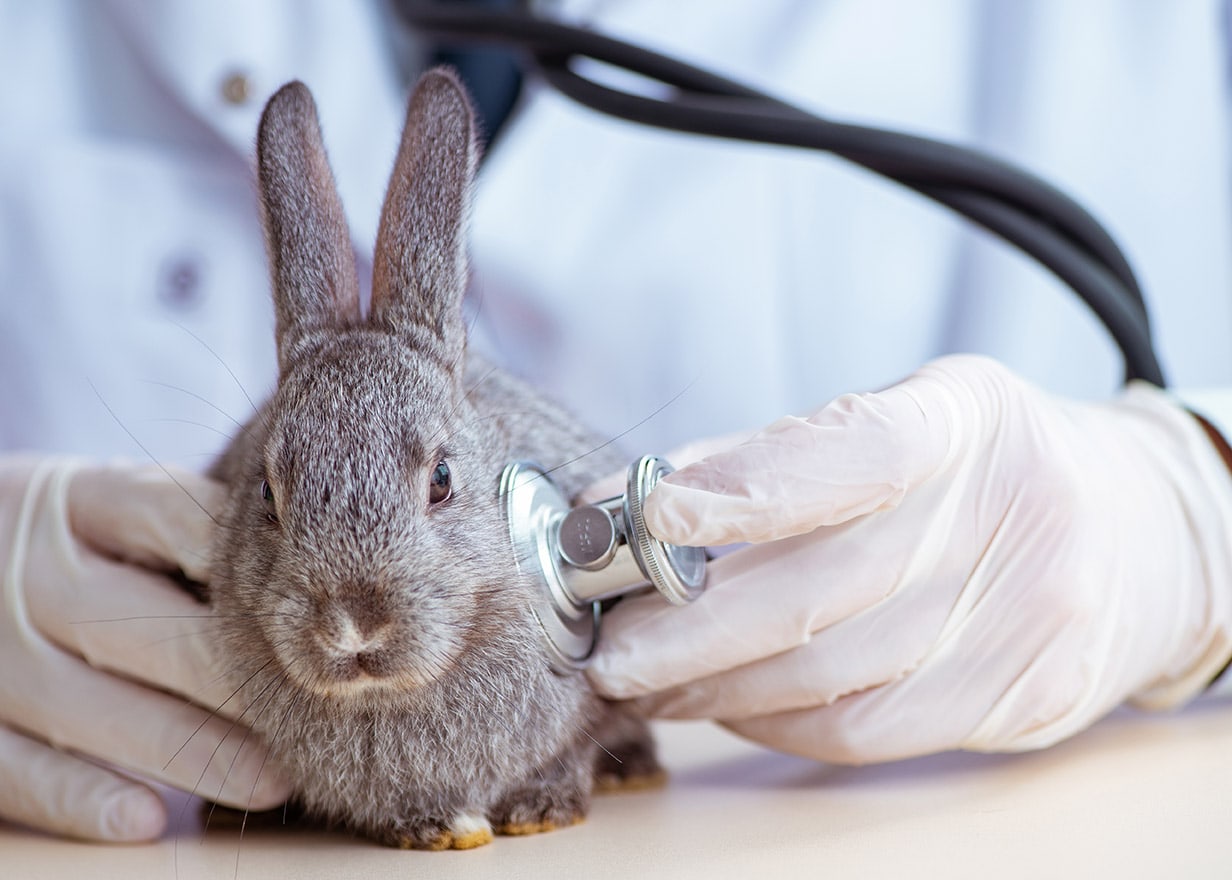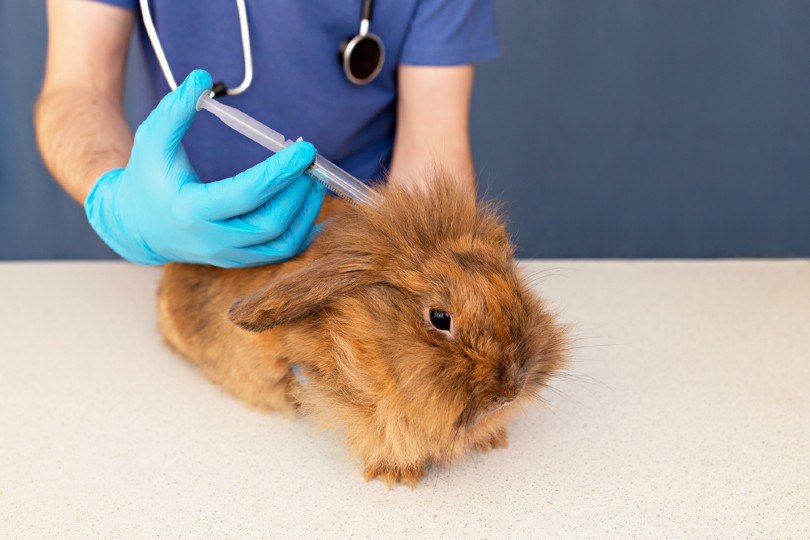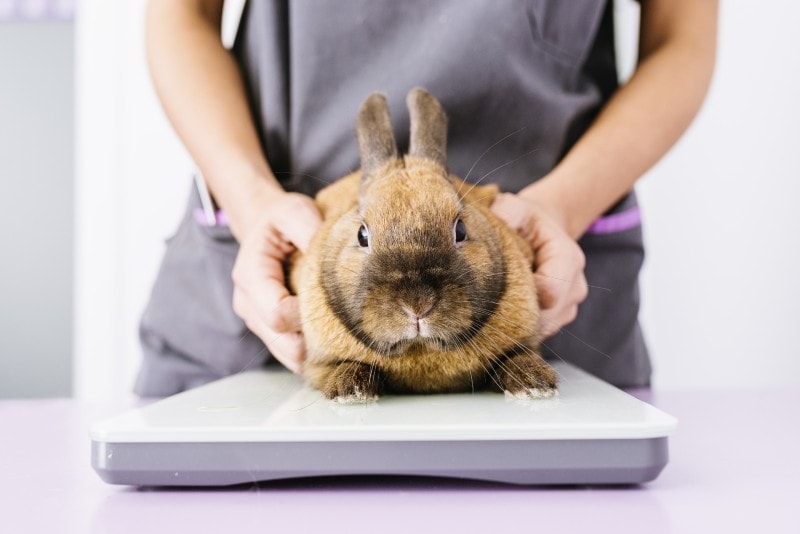
Learning all you can about your pets can be daunting, especially when it comes to health. Animals like rabbits are incredibly good at hiding illness because they are prey animals—it can be tough to detect when your rabbit is sick. Any time a rabbit stops eating should be taken seriously and warrants a trip to the vet.
Here, we will discuss some of the more common things that can go wrong with your rabbits’ health. Many are preventable with proper care so getting your housing, diet and care regime right are hugely important.
The 8 Common Diseases & Disorders in Rabbits
Many rabbits will live long happy lives with no problems but others are not so lucky. You must monitor your bunny daily for signs of illness, discomfort and disease. Granted, sudden emergency issues can arise out of your control but many illnesses are preventable or minimized with proper care. Here are eight of the more common problems your rabbit may face.
1. Overgrown Teeth
Overgrown teeth and dental disease are some of the most common issues in domestic rabbits. Because their teeth grow continuously throughout their lifetime, they can become quickly overgrown. Dental disease can cause, and be caused by: alignment issues, infections, injuries, diet and stopping eating for any reason.
Prevention
Your rabbit requires gnawing and chowing down on fibrous greens daily. To prevent overgrowth, you must provide an appropriate diet. 5% Extruded rabbit pellets, 10% fresh veg and fruit 85% good quality timothy hay.
Treatment
Overgrown teeth can be quite painful, so it’s essential to avoid it as much as possible! However, if you find this has become a problem, the vet will be able to help you out. Dental treatment and possibly x-rays will be needed.

2. Hairballs
Rabbits are very clean animals that keep up with routine hygiene. However, they can sometimes develop hairballs, which can be dangerous. These are much more common in rabbits with gastrointestinal troubles.
Prevention
Have your rabbit’s health and habits checked regularly by your chosen vet? Ensuring your rabbit is in good health is the best way to prevent hairballs. It’s best to make sure your rabbit is getting plenty of fiber in their diet to help the system run smoothly. If you have a long-haired rabbit make sure you are grooming it regularly.
Treatment
Hairballs can be difficult to treat. Often surgery is necessary to remove the hairball from the gut. However, your vet might give medication to induce bowel movements, trying to pass the hairball along. Intravenous fluids and other treatments may be needed.
3. Rabbit Hemorrhagic Disease (RHD1 and 2)
Also known as viral hemorrhagic disease, VHD, it is an extremely infectious, rapidly fatal, viral hepatitis caused by a Calicivirus. This disease is spread easily by many routes including direct contact with infected rabbits or indirect contact from animals or materials such as hay and flies. It is a notifiable disease in the USA.
Sadly most of the time, rabbits don’t show any symptoms before dying suddenly.
Prevention
There is a vaccination to prevent your rabbit from contracting this illness. Contact your veterinarian for advice in your region.
Treatment
If the disease is detected early, supportive treatment might help but sadly many cases are fatal or show no signs before sudden death.

4. Myxomatosis
Myxomatosis is a viral disease that is spread easily from a sick to a healthy rabbit directly and also via mosquito and flea bites. Unfortunately, this is another highly infectious and often fatal disease of rabbits. In the USA it is more confined to coastal areas of California and Oregon. It is widespread in many other countries.
Prevention
Regular vaccination against Myxomatosis is highly recommended for preventing this fatal viral disease. Having the proper flea treatment on your rabbit is also highly recommended.
Treatment
Unfortunately, there is no cure for myxomatosis but supportive treatment and veterinary care may help in some cases.
5. Pasteurella
Pasteurella multocida is a highly contagious bacterial infection spread from rabbit to rabbit through liquid excretions. It is usually contracted immediately after birth as most adult rabbits are thought to be infected, although many have no symptoms. It is one of the main causes of rabbit Snuffles.
Prevention
It is very difficult to prevent infection as it is so widespread, however, it is more likely to cause symptoms during times of stress and reduced immunity. Quarantining new rabbits and monitoring rabbits after a stressful change can reduce the development of this infection.
Treatment
Antibiotics can be prescribed after examination by your veterinarian, but it is very difficult to eradicate the bacteria. Sometimes, surgery is necessary for the treatment of abscesses in combination with antibiotics.

6. Uterine Tumors
Female rabbits that have never been spayed are quite prone to developing uterine tumors, around 60% of females over the age of 3 years. These tumors are most commonly uterine adenocarcinoma.
Prevention
Getting your rabbit fixed before sexual maturity will prevent uterine tumors. Desexing female rabbits is best around 4 to 6 months of age.
Treatment
Spaying is the standard treatment for uterine tumors, the uterus and ovaries are removed. However, the cancer usually spreads to other organs quite early in the course of the illness and surgery will not be curative in this situation.
7. Various Parasites
Like most other animals, rabbits are susceptible to various parasites and worms in their digestive tracts and other organs.
Prevention
Giving your rabbit a routine deworming treatment can kill any existing parasite and prevent any future ones. Keep them on a routine schedule as advised by your vet. If your rabbit recently had worms, ensure you have thoroughly sanitized the cage and filled it with new toys, hideaways, and bedding to avoid recontamination.
Treatment
Your vet will prescribe an antiparasitic treatment based on the type of worms your rabbit has, age and weight of your rabbit.

8. Coccidiosis
Coccidiosis is caused by a single-celled organism, a protozoa, which affects the intestinal tract. It can quickly cause troublesome symptoms and requires vet attention for successful treatment.
Prevention
Since it is contagious, keep new rabbits quarantined for at least a week before introductions. Ensure all rabbits are treated promptly to prevent them from spreading it in their feces.
Treatment
Even though younger rabbits or those with lower immunities might struggle to recover from this infection, it’s usually treatable with proper veterinary care.
 How to Keep Your Rabbit Healthy
How to Keep Your Rabbit Healthy
Rabbits are an increasingly popular pet and not just with children. In fact they require more care and attention than they have traditionally been given. Knowledge of how to take care of their needs is pivotal to their health and well-being.
Species Appropriate Diet
Rabbits are herbivores with constantly growing teeth and special digestive systems. They need to eat large volumes of grass or hay daily to provide the fiber and other nutrients they need. The recommended guidelines are 5% extruded good quality rabbit nuggets, 10% fresh vegetables and fruit, and 85% good quality timothy hay or grass.
Adequate space
Living in a hutch year-round is not sufficient for a healthy rabbit. They need adequate room to dig, jump, run, hop, and forage around and explore on a daily basis. Aim for a minimum of 10ft x 6ft x 3ft.
Companionship
Rabbits should live with another rabbit as a companion. A sterilized male and female pairing is ideal.
Don’t Introduce New Rabbits Immediately
When you get new rabbits, you should keep them in a quarantine period for about two weeks. If the new rabbit displays any signs of illness, you can address it in that timeframe. If you put the rabbits together immediately, any potential illness that the new rabbit has can potentially pass to all of your others.
Routinely Take Rabbits to the Vet
Rabbits might seem like they don’t require as much care as a dog or cat, but this couldn’t be further from the truth. Rabbits really benefit from a minimum of annual checkups just like any other pet. Your vet can give them a general exam and run any additional testing if needed. Vaccinations and worming regularly will help to prevent several infectious diseases.

Desex Your Females
For any reproductive health issues, desexing your females before they reach sexual maturity between four and six months of age is best. This will remove the risk of uterine cancers later in life and prevent unplanned breeding.
Pet Insurance for Rabbits
Healthcare is a financial commitment that must be considered when taking on a new pet. Explore the options of pet insurance to help cover the costs of unexpected vet visits.
Final Thoughts
With our list of 8 of the more common diseases and disorders of rabbits, you will have a better idea of symptoms and signs to watch out for. Rabbits are experts in hiding illness and discomfort so take the time to get to know their routines and habits so that you can be on the alert for subtle changes. Any time a rabbit stops eating, it should prompt a call to your veterinarian.
Remember, routine vet care is critical, even for our rabbit friends. Make sure that you have a rabbit-savvy vet on hand to routinely check your rabbit over and give advice.
Featured Image Credit: Elnur, Shutterstock



 How to Keep Your Rabbit Healthy
How to Keep Your Rabbit Healthy





